[Early form of Wilkie's syndrome: a rare complication of scoliosis surgery, about a case and review of the literature]
- PMID: 28292053
- PMCID: PMC5325508
- DOI: 10.11604/pamj.2016.25.90.8773
[Early form of Wilkie's syndrome: a rare complication of scoliosis surgery, about a case and review of the literature]
Abstract
Superior mesenteric artery syndrome is a rare complication occurring after surgical treatment for scoliosis. Surgical correction of the scoliotic spine produces vertical traction on the mesenteric artery and the narrowing of the aortomesenteric angle, hence the compression of the third part of the duodenum causing the syndrome. We here report the case of a young girl with an early form of superior mesenteric artery syndrome secondary to surgical correction of idiopathic scoliosis. The patient underwent posterior spinal fusion for idiopathic scoliosis. On the third postoperative day she experienced uncontrollable vomiting associated with no evacuation of faeces and no passing of flatus. Urgent abdominal CT scan was performed which allowed the diagnosis of superior mesenteric artery syndrome. Treatment consisted in the rest of the digestive tract associated with early parenteral nutrition and correction of fluid and electrolyte imbalances. Lacking evidence of clinical improvement, surgical indication was posed. The evolution was favourable with an uneventful postoperative recovery and the resumption of adequate food intake on the fourth postoperative day. The patient was discharged on the seventh postoperative day. Contributing factors are young age, long-limbed morphotype with BMI below 18. CT scan shows an important gastric dilatation associated with complete halt of the third part of the duodenum. The treatment is multidisciplinary, medical (first-line treatment) and surgical (if medical treatment do not help). A better knowledge of the predictors of medical treatment failure would reduce the length of hospital stay.
Le syndrome de la pince aorto-mésentérique est une complication rare pouvant survenir après une correction chirurgicale de scoliose. Les phénomènes de traction verticale de l’artère mésentérique et le rétrécissement de l’angle aorto-mésentérique lors de la correction sont à l’origine de ce syndrome par compression du troisième duodénum. Nous rapportons ici l’observation d’un cas précoce de syndrome de la pince aorto-mésentérique secondaire à une correction chirurgicale d’une scoliose idiopathique chez une fille. Une jeune fille opérée d’une arthrodèse vertébrale postérieure pour une scoliose idiopathique avait présenté au troisième jour postopératoire des vomissements incoercibles avec arrêt des matières et des gaz. Le scanner abdominal réalisé en urgence avait permis le diagnostic d’un syndrome de l’artère mésentérique supérieure. La prise en charge consistait à une mise au repos du tube digestif associé à une nutrition parentérale précoce et une correction des déséquilibres hydroélectrolytiques. Devant l’absence d’amélioration clinique, l’indication opératoire fut posée. L’évolution a été favorable avec des suites opératoires simples et une reprise alimentaire orale à quatrième jour, une sortie à domicile au septième jour postopératoire.Les facteurs favorisants sont les sujets jeunes, de morphotype longiligne avec un faible IMC inférieur à 18.Les signes scannographiques sont une dilatation gastrique importante avec un arrêt net au niveau de 3ème duodénum. La prise en charge est multidisciplinaire étant médicale d’abord et chirurgicale en cas d’échec. Une meilleure connaissance des facteurs prédictifs d’échec du traitement médical permettrait de réduire la durée de séjour hospitalier.
Keywords: Superior mesenteric artery; duodenal obstruction; idiopathic scoliosis.
Conflict of interest statement
Les auteurs ne déclarent aucun conflit d’intérêt.
Figures
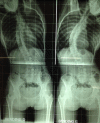
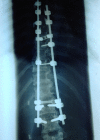
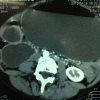
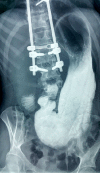
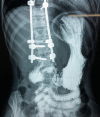
References
-
- Welsch T, Büchler MW, Kienle P. Recalling Superior MesentericArtery Syndrome. Digestive Surgery. 2007 Apr;24(3):149–56. - PubMed
-
- Zadegan F, Lenoir T, Drain O, et al. Syndrome de la pince aorto-mésentérique après correction d'une déformation rachidienne: À propos d’un cas et revue de la literature. Rev Chir Orthop Réparatrice Appar Mot. 2007 Apr;93(2):181–5. - PubMed
-
- Goin LS, Wilk SP. Intermittent arteriomesenteric occlusion of the duodenum. Radiology. 1956 Nov;67(5):729–737. - PubMed
-
- Tsirikos AI, Jeans LA. Superior mesentericartery syndrome in children and adolescents withspinedeformitiesundergoing corrective surgery. J Spinal disordtech. 2005 Jun;18(3):263–71. - PubMed
-
- Smith GG, Hakim-Zargar M, Thomson JD. Low body mass index: a risk factor for superiormesentericartery syndrome in adolescents undergoing spinal fusion for scoliosis. J spinal Disord Tech. 2009 Apr;22(2):144–8. - PubMed
Publication types
MeSH terms
LinkOut - more resources
Full Text Sources
Other Literature Sources
Medical
